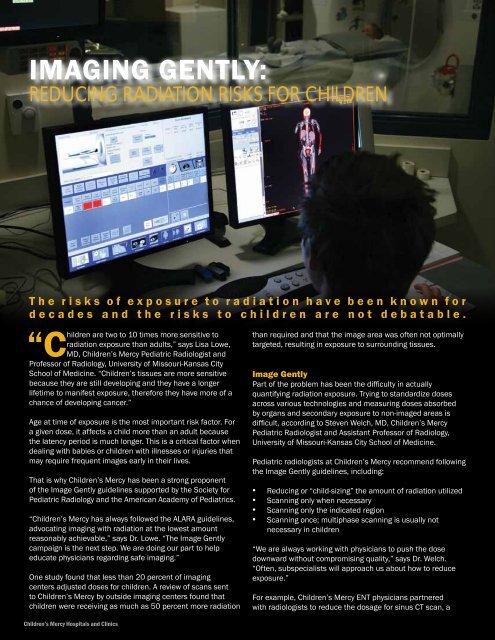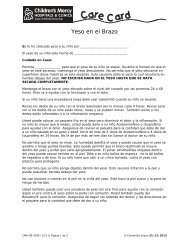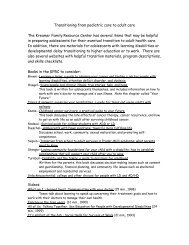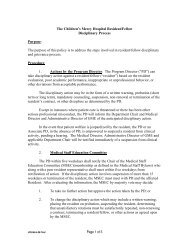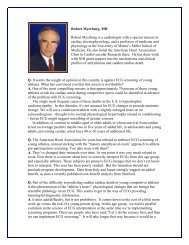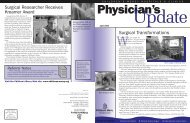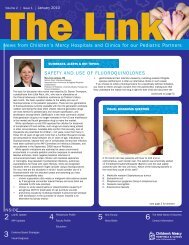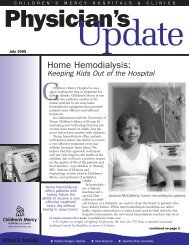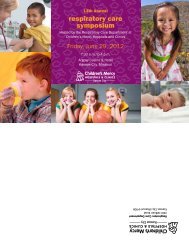Pediatric Imaging - Children's Mercy Hospitals and Clinics
Pediatric Imaging - Children's Mercy Hospitals and Clinics
Pediatric Imaging - Children's Mercy Hospitals and Clinics
You also want an ePaper? Increase the reach of your titles
YUMPU automatically turns print PDFs into web optimized ePapers that Google loves.
<strong>Imaging</strong> Gently:REDUCiNG RADiAtiON RiSKS FOr CHiLDrENThe risks of exposure to radiation have been known fordecades <strong>and</strong> the risks to children are not debatable.are two to 10 times more sensitive toradiation exposure than adults,” says Lisa Lowe,“ChildrenMD, Children’s <strong>Mercy</strong> <strong>Pediatric</strong> Radiologist <strong>and</strong>Professor of Radiology, University of Missouri-Kansas CitySchool of Medicine. “Children’s tissues are more sensitivebecause they are still developing <strong>and</strong> they have a longerlifetime to manifest exposure, therefore they have more of achance of developing cancer.”Age at time of exposure is the most important risk factor. Fora given dose, it affects a child more than an adult becausethe latency period is much longer. This is a critical factor whendealing with babies or children with illnesses or injuries thatmay require frequent images early in their lives.That is why Children’s <strong>Mercy</strong> has been a strong proponentof the Image Gently guidelines supported by the Society for<strong>Pediatric</strong> Radiology <strong>and</strong> the American Academy of <strong>Pediatric</strong>s.“Children’s <strong>Mercy</strong> has always followed the ALARA guidelines,advocating imaging with radiation at the lowest amountreasonably achievable,” says Dr. Lowe. “The Image Gentlycampaign is the next step. We are doing our part to helpeducate physicians regarding safe imaging.”One study found that less than 20 percent of imagingcenters adjusted doses for children. A review of scans sentto Children’s <strong>Mercy</strong> by outside imaging centers found thatchildren were receiving as much as 50 percent more radiationthan required <strong>and</strong> that the image area was often not optimallytargeted, resulting in exposure to surrounding tissues.Image GentlyPart of the problem has been the difficulty in actuallyquantifying radiation exposure. Trying to st<strong>and</strong>ardize dosesacross various technologies <strong>and</strong> measuring doses absorbedby organs <strong>and</strong> secondary exposure to non-imaged areas isdifficult, according to Steven Welch, MD, Children’s <strong>Mercy</strong><strong>Pediatric</strong> Radiologist <strong>and</strong> Assistant Professor of Radiology,University of Missouri-Kansas City School of Medicine.<strong>Pediatric</strong> radiologists at Children’s <strong>Mercy</strong> recommend followingthe Image Gently guidelines, including:• Reducing or “child-sizing” the amount of radiation utilized• Scanning only when necessary• Scanning only the indicated region• Scanning once; multiphase scanning is usually notnecessary in children“We are always working with physicians to push the dosedownward without compromising quality,” says Dr. Welch.“Often, subspecialists will approach us about how to reduceexposure.”For example, Children’s <strong>Mercy</strong> ENT physicians partneredwith radiologists to reduce the dosage for sinus CT scan, a


